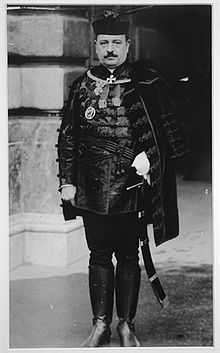Bálint Hóman
| Bálint Hóman | |
|---|---|
 | |
| Minister of Religion and Education of Hungary | |
| In office 1 October 1932 – 14 May 1938 | |
| Preceded by | Jenő Karafiáth |
| Succeeded by | Pál Teleki |
| In office 16 November 1939 – 3 July 1942 | |
| Preceded by | Pál Teleki |
| Succeeded by | Jenő Szinyei Merse |
| Personal details | |
| Born | 29 December 1885 |
| Died | 2 June 1951 (aged 65) |
| Political party | Party of National Unity, Party of Hungarian Life |
| Profession | politician, historian |
Bálint Hóman (29 December 1885 – 2 June 1951) was a Hungarian politician, who served as Minister of Religion and Education twice: between 1932–1938 and between 1939–1942.
Academic career
He was born into a Roman Catholic family. He finished his studies in Budapest. He started his career when he has been student yet, worked for the University Library of Budapest. He was appointed director of the National Széchényi Library in 1922, and of the Hungarian National Museum in 1923, which position was hold until 1932 by him.
Hóman hulled serious scientific works during his life. The centre of his researches was the history of the Hungarian nation during the Middle Ages. At the beginnings he dealt with the economic history, social history and the auxiliary sciences of history. He wrote about the Hungarian towns during the Árpád era, the social class, the first state tax and about the Magyar tribes who arrived to the Carpathian Basin. His bulky work was published with a title of History of the Hungarian Currency 1000–1325, he systematized the Hungarian currency of the Middle Ages' chronology, metrology and history. His other fundamental work was The finance affairs and economic policy of the Kingdom of Hungary during the reign of Charles Robert.
He published many essays and books together with Gyula Szekfű. Their most notorious work is the Hungarian history. According to his point of view that is necessary to take it into consideration at the time of the analysis of the ancient Hungarian words the Sumerian and Hattian–Hurrian literary monuments.
Political career
Hóman represented the German orientation of the Hungarian politics from the 1930s. He served as Minister of Religion and Education in the cabinet of Gyula Gömbös and Kálmán Darányi. After one-year gap he was appointed minister again. He was the deputy chairman of the Party of National Unity from 1938.
He opposed the peace negotiations of 1943 with the western allies. He also took a part in the legislation after the German occupation (March 1944) and the coup d'état of the Arrow Cross Party (October 1944). When the Red Army entered the Hungarian border in December 1944, he moved to Transdanubia along with the other Arrow Cross Party members (including Ferenc Szálasi). Later he escaped to Germany, but the American troops captured him. The People's Tribunal sentenced to life imprisonment because of charge of war crimes in 1946. Hóman spent his punishment in Vác, where his biological organisation carried the trials difficultly. According to reports the grew man lost 60 kilograms of his weight during short time. Hóman died on 2 June 1951.
Publications
- A magyar városok az Árpádok korában [Hungarian towns during the Árpád era] (Budapest, 1908)
- Magyar pénztörténet 1000–1325 [History of the Hungarian Currency 1000–1325] (Budapest, 1916)
- A magyar királyság pénzügyei és gazdaságpolitikája Károly Róbert korában [The finance affairs and economic policy of the Kingdom of Hungary during the reign of Charles Robert] (Budapest, 1921)
- A Szent László-kori Gesta Ungarorum és a XII–XIII. századi leszármazói [The Saint Ladislaus aged Gesta Hungarorum and its ancestors of the 12th–13th century] (Budapest, 1925)
- A magyar hun hagyomány és hun monda [The Hungarian Hunnic tradition and Hunnic legend] (Budapest, 1925)
- A forráskutatás és forráskritika története [History of the source research and source criticism] (Budapest, 1925)
- Magyar történet [Hungarian History] (1458-ig, a továbbiakat Szekfű Gyula írta; Budapest, é. n. )
- Egyetemes történet [World history] (I–IV. Szerk.: H. B., Szekfű Gyula, Kerényi Károly; Budapest, 1935–1937)
- Ősemberek – Ősmagyarok [Prehistoric men – Prehistoric Hungarians] (Atlanta, 1985)
- A történelem útja. Válogatott tanulmányok [The way of the history. Selected studies] (Vál.: Buza János; Budapest, 2002)
References
| Political offices | ||
|---|---|---|
| Preceded by Jenő Karafiáth |
Minister of Religion and Education 1932–1938 |
Succeeded by Pál Teleki |
| Preceded by Pál Teleki |
Minister of Religion and Education 1939–1942 |
Succeeded by Jenő Szinyei Merse |
| |||||||||||||||||||||||||||||||||||
|